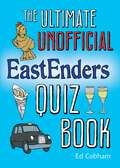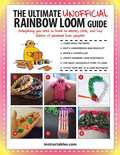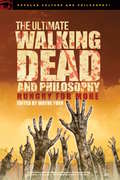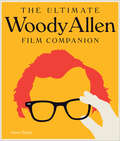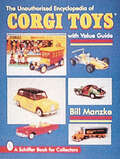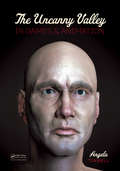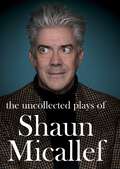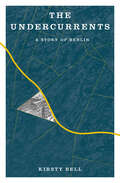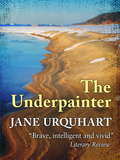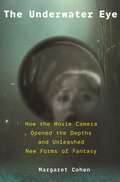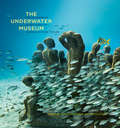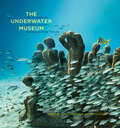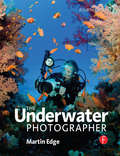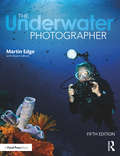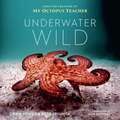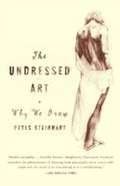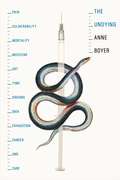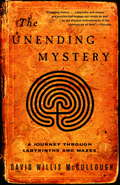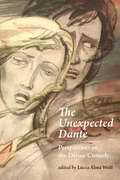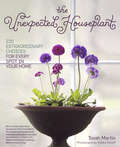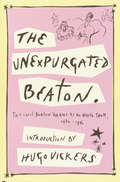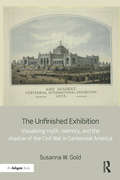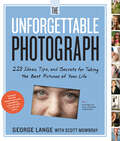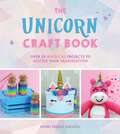- Table View
- List View
The Ultimate Unofficial Eastenders Quiz Book
by Ed CobhamSo you think you're one of Eastenders' biggest fans? Test your knowledge with this trivia quiz book:How many times has Sharon been married? What colour was the original exterior of the Queen Vic? If you think you’re practically a resident of the square, these brain teasing questions will drive you Dotty until you've got them all!
The Ultimate Unofficial Eastenders Quiz Book
by Ed CobhamSo you think you're one of Eastenders' biggest fans? Test your knowledge with this trivia quiz book:How many times has Sharon been married? What colour was the original exterior of the Queen Vic? If you think you’re practically a resident of the square, these brain teasing questions will drive you Dotty until you've got them all!
The Ultimate Unofficial Rainbow Loom® Guide: Everything You Need to Know to Weave, Stitch, and Loop Your Way Through Dozens of Rainbow Loom Projects
by Instructables. ComThe best book for beautiful Rainbow Loom instructions!With millions of Rainbow Looms sold, the colorful toy is off to a sizzling start and shows no signs of stopping.<P><P> Skyhorse Publishing and Instructables join forces to bring you the best in Rainbow Loom projects. From toys to jewelry, The Ultimate Unofficial Rainbow Loom® Guide will show you just how much you can do with a few rubber bands, a hook, and a little imagination. Brought to you by the very best Rainbow Loom enthusiasts at Instructables, these projects will keep you looping and weaving for hours on end. There's no need to fear confusing instructions: these projects are made by loomers just like you. Learn how to: Loop your way to a cute ring Weave a fishtail bracelet Make your own Rainbow Loom poodle Stitch together Rainbow Loom shoes Create vegetable garden charms Use a fork to make a necklaceFrom simple rings to funky goldfish charms, the looming-made-easy instructions allow anyone to master the Rainbow Loom. Create funky bracelets to stack on your arm, or surprise your best friend with a customized charm necklace. Spice up every day household objects with Rainbow Loom accessories. Because the simple steps are paired with clear photographs, when in doubt, just look! Multiple project options give you the opportunity to find the best way of creating your rainbow collection. After all, every craftsman has a unique way of doing things. So bust out your loom and gear up for a heavy dose of color-The Ultimate Unofficial Rainbow Loom® Guide will turn you into a loomer extraordinaire.
The Ultimate Walking Dead and Philosophy
by Wayne YuenIn The Walking Dead, human beings are pushed to their limits by a zombie apocalypse and have to decide what really matters. <P><P>Good and evil, freedom and slavery, when one life has to be sacrificed for another, even the nature of religion-all the ultimate questions of human existence are posed afresh as the old society crumbles away and a new form of society emerges, with new beliefs and new rules. The Ultimate Walking Dead and Philosophy brings together twenty philosophers with different perspectives on the imagined world of this addictive TV show. How can we keep our humanity when faced with such extreme life-or-death choices? Did Dr. Jenner do the right thing in committing suicide, when all hope seemed to be lost? Does the Governor, as the new Machiavelli, prove that willingness to repeatedly commit murder is the best technique for getting and keeping political power? Why do most characters place such importance on keeping particular individuals alive, especially children? What can we learn about reality from Rick's haunting hallucinations?
The Ultimate Woody Allen Film Companion
by Jason BaileyA complete look at the extensive, ageless, unparalleled filmography of Woody Allen. Writer, actor, director, comedian, author, and musician, Woody Allen is one of the most culturally and cinematically influential filmmakers of all time. His films - he has over 45 writing and directing credits to his name - range from slapstick to tragedy, farce to fantasy. As one of history's most prolific moviemakers, his style and comic sensibility have been imitated, but never replicated, by countless other filmmakers over the years. In The Ultimate Woody Allen Film Companion, film writer Jason Bailey profiles every one of Allen's films: from his debut feature, What's Up, Tiger Lily, through slapstick classics such as Take the Money and Run and Sleeper; Academy Award-winning films such as Annie Hall and Hannah and Her Sisters; and recent gems such as Midnight in Paris and Blue Jasmine. Bailey also includes essays on the fascinating themes that color Allen's works, from death and Freud to music and New York City. Getting up close and personal with the actors and actresses that have brought the iconic films to life, this book's behind-the-scenes stories span the entire career of a man whose catalog has grown into a timeless cornerstone of American pop culture. Complete with full cast lists, production details, and full-color images and artwork, The Ultimate Woody Allen Film Companion is the ultimate, indispensable reference to one of cinema's most beloved and important figures.
The Unauthorized Encyclopedia of Corgi Toys
by Bill ManzkeHop in for a complete tour of the tiny world this British toy maker created. Explore four decades of diecast production, following the route the industry took as it shed outdated techniques for state-of-the-art cars James Bond would have been proud of. Written from the unique perspective of an American collector, the book presents topics never before discussed in print, chronicling the rise, fall, and rebirth of Corgi Toys, all illustrated with hundreds of color photos of models and memorabilia never before seen in print. The smaller Husky and Corgi Juniors lines, often neglected in other books, are also covered. Other sections examine Corgi clubs, marketing, packaging, memorabilia, and special interest groupings. Most importantly, this encyclopedia presents the most complete variation listing and value guide published to date, including sections covering Corgi, Husky, and Juniors models from their introduction through the present day.
The Uncanny Valley in Games and Animation
by Angela TinwellAdvances in technology have enabled animators and video game designers to design increasingly realistic, human-like characters in animation and games. Although it was intended that this increased realism would allow viewers to appreciate the emotional state of characters, research has shown that audiences often have a negative reaction as the human
The Uncollected Plays of Shaun Micallef
by Shaun MicallefShaun Micallef is without doubt Australia's premier comedian, writer, producer, presenter, actor, author, broadcaster, bon vivant, gadfly, troubadour, dancer, impresario, acrobat, lion tamer, poet and elite sportsman. But did you know that he is also an internationally renowned playwright? No? Typical. It really is a stain on our national character that this doyen of theatre doesn't get the credit he deserves or attention he craves in this country - mute testimony to Australia's cultural cringe and inveterate idiocy. From Broadway to the West End, his name is mentioned in the same breath as Mamet and Ray Cooney; and in the salons of Paris Micallef is worshipped as a god. His plays, uncollected until now, are irrefutable proof that when it comes to listing the world's greatest dramatists, the name Micallef should be inserted in there somewhere. Even if you have never been to the theatre before, just holding this book in your hands as you are now will change your life forever. You'll laugh, you'll cry, your body will spasm convulsively and you may even be so moved that you will open the book and read it.
The Undercurrents: A Story of Berlin
by Kirsty BellHumane, thought provoking, and moving, this hybrid literary portrait of a place makes the case for radical close readings: of ourselves, our cities, and our histories.The Undercurrents is a dazzling work of biography, memoir, and cultural criticism told from a precise vantage point: a stately nineteenth-century house on Berlin&’s Landwehr Canal, a site at the center of great historical changes, but also smaller domestic ones. The view from this house offers a ringside seat onto the city&’s theater of action. The building has stood on the banks of the canal since 1869, its feet in the West but looking East, right into the heart of a metropolis in the making, on a terrain inscribed indelibly with trauma. When her marriage breaks down, Kirsty Bell—a British-American art critic, adrift in her midforties—becomes fixated on the history of her building and of her adoptive city. Taking the view from her apartment window as her starting point, she turns to the lives of the house&’s various inhabitants, to accounts penned by Walter Benjamin, Rosa Luxemburg, and Gabriele Tergit, and to the female protagonists in the works of Theodor Fontane, Irmgard Keun, and Rainer Werner Fassbinder. A new cultural topography of Berlin emerges, one which taps into energetic undercurrents to recover untold or forgotten stories beneath the city&’s familiar narratives.
The Underpainter
by Jane UrquhartThe Underpainter is a novel of interwoven lives in which the world of art collides with the realm of human emotion. It is the story of Austin Fraser, an American painter now in his later years, who is haunted by memories of those whose lives most deeply touched his own, including a young Canadian soldier and china painter and the beautiful model who becomes Austin's mistress. Spanning decades, the setting moves from upstate New York to the northern shores of two Great Lakes; from France in World War One to New York City in the '20s and '30s. Brilliantly depicting landscape and the geography of the imagination, The Underpainter is Jane Urquhart's most accomplished novel to date.
The Underwater Eye: How the Movie Camera Opened the Depths and Unleashed New Realms of Fantasy
by Margaret CohenA rich history of underwater filmmaking and how it has profoundly influenced the aesthetics of movies and public perception of the oceansIn The Underwater Eye, Margaret Cohen tells the fascinating story of how the development of modern diving equipment and movie camera technology has allowed documentary and narrative filmmakers to take human vision into the depths, creating new imagery of the seas and the underwater realm, and expanding the scope of popular imagination. Innovating on the most challenging film set on earth, filmmakers have tapped the emotional power of the underwater environment to forge new visions of horror, tragedy, adventure, beauty, and surrealism, entertaining the public and shaping its perception of ocean reality.Examining works by filmmakers ranging from J. E. Williamson, inventor of the first undersea film technology in 1914, to Wes Anderson, who filmed the underwater scenes of his 2004 The Life Aquatic with Steve Zissou entirely in a pool, The Underwater Eye traces how the radically alien qualities of underwater optics have shaped liquid fantasies for more than a century. Richly illustrated, the book explores documentaries by Jacques Cousteau, Louis Malle, and Hans Hass, art films by Man Ray and Jean Vigo, and popular movies and television shows such as 20,000 Leagues Under the Sea, Creature from the Black Lagoon, Sea Hunt, the Bond films, Jaws, The Abyss, and Titanic. In exploring the cultural impact of underwater filmmaking, the book also asks compelling questions about the role film plays in engaging the public with the remote ocean, a frontline of climate change.
The Underwater Museum: The Submerged Sculptures of Jason deCaires Taylor
by Helen Scales Jason DeCaires Taylor Carlo McCormickA one-of-a-kind blend of art, nature, and conservation, The Underwater Museum re-creates an awe-inspiring dive into the dazzling under-ocean sculpture parks of artist Jason deCaires Taylor. Taylor casts his life-size statues from a special kind of cement that facilitates reef growth, and sinks them to the ocean floor. There, over time, the artworks attract corals, algae, and fish, and evolve into beautiful and surreal installations that are also living reefs. This volume brings readers face to face with these wonders and explains the science behind their creation. Ocean enthusiasts, divers, art lovers, and anyone entranced by the natural world will be instantly engrossed by this pearl of a book.
The Underwater Museum: The Submerged Sculptures of Jason deCaires Taylor
by Jason Decaires Taylor Helen Scales Carlo MccormickA one-of-a-kind blend of art, nature, and conservation, The Underwater Museum re-creates an awe-inspiring dive into the dazzling under-ocean sculpture parks of artist Jason deCaires Taylor. Taylor casts his life-size statues from a special kind of cement that facilitates reef growth, and sinks them to the ocean floor. There, over time, the artworks attract corals, algae, and fish, and evolve into beautiful and surreal installations that are also living reefs. This volume brings readers face to face with these wonders and explains the science behind their creation. Ocean enthusiasts, divers, art lovers, and anyone entranced by the natural world will be instantly engrossed by this pearl of a book.
The Underwater Photographer
by Martin EdgeThe award-winning third edition of 'The Underwater Photographer' dragged the topic kicking and screaming in to the digital age and with the fully updated fourth edition highly respected photographer and tutor Martin Edge takes you deeper in to the world of Underwater Photography.Practical examples take you step-by-step through the basic techniques from photographing shipwrecks, divers, marine life and abstract images to taking photographs at night. Brand new chapters cover not only highly specialist Underwater Photography techniques such as low visibility/greenwater photography, but also the digital workflow needed to handle your images using the latest software such as Lightroom. Packed with breathtaking images and an easy to read style honed from over twenty years of diving photography courses, this book is sure to both educate and inspire underwater photographers of all skill levels.
The Underwater Photographer: Digital And Traditional Techniques
by Martin Edge Stuart GibsonIn this long-awaited fifth edition of the best-selling book, Martin Edge continues to provide the definitive guide to underwater photography. The book covers everything from the basic principles, the equipment and approaches to composition and lighting through to creating an individual style. The book features over 400 updated colour images - taken on numerous dives around the world - with an accompanying narrative that provides detailed information on how the shots were taken, their strengths and weaknesses and how to fix mistakes. Practical examples take you step-by-step through the basic techniques: photographing shipwrecks, divers, marine life, macro images and taking photographs at night. New chapters cover the latest equipment, processes and techniques including SLR Cameras, water contact lenses, mirrorless interchangeable lens cameras, micro four third systems, super macro techniques, motion blur, LED lighting and more. Packed with inspiring examples from global diving destinations and speciality chapters written by professionals in the field, this book is an indispensable masterclass for both the novice and seasoned underwater photographer.
The Underwater Wild: My Octopus Teacher's Extraordinary World
by Craig Foster Ross FrylinckFrom the creators of the Academy Award-winning documentary My Octopus Teacher, an immersive journey into the underwater world that inspired it—and holds transformative lessons for us all Craig Foster and Ross Frylinck regularly dive together in the awe-inspiring kelp forests off South Africa, without wetsuits or oxygen tanks. Craig had dived this way for years, including alongside the octopus that inspired My Octopus Teacher. In Ross, he found a kindred spirit, someone who also embraced the ancient methods of acclimating his body to frigid waters, but whose eyes had not yet adjusted to the transcendent wonder Craig saw each time they dove. In the heart-wrenching stories that make up this unforgettable book, we swim alongside Ross as he grows from skeptic to student of the underwater wild. And in the revelatory marine science behind the stunning photos, we learn how to track sea hares, cuttlefish, and limpets, and we witness strange new behaviors never before documented in marine biology. We realize that a whole world of wonder, and an innate wildness within us all, emerge anew when we simply observe. My Octopus Teacher has captivated millions who long to connect with the natural world. Now, with Underwater Wild, the divers behind the film reveal a new vision of the sea, one full of wonder, new insights into marine biology, and life-changing teachings for even the most land-bound of us.
The Undressed Art: Why We Draw
by Peter SteinhartTo draw is to understand what we see. In The Undressed Art, writer-naturalist Peter Steinhart investigates the rituals, struggles, and joys of drawing. Reflecting on what is known about the brain's role in the drawing process, Steinhart explores the visual learning curve: how children begin to draw, how most of them stop, and what brings adults back to this deeply human art form later in life He considers why the face and figure are such commanding subjects and describes the delicate collaboration of the artist and model. Here is a powerful reminder that no revolution in art or technology can undermine our vital need to draw.
The Undying: Pain, Vulnerability, Mortality, Medicine, Art, Time, Dreams, Data, Exhaustion, Cancer, and Care
by Anne BoyerThe Undying explores the experience of illness as mediated by digital screens, weaving in ancient Roman dream diarists, cancer hoaxers and fetishists, cancer vloggers, corporate lies, John Donne, pro-pain "dolorists," the ecological costs of chemotherapy, and the many little murders of capitalism.
The Unending Mystery: A Journey Through Labyrinths and Mazes
by David Willis McculloughThe Unending Mystery is a charming, offbeat, generously illustrated exploration of a form that has had a place in the culture of almost every civilization since the beginning of human history--and is now experiencing a modern revival. Labyrinths appear on Neolithic rock outcroppings and in some of the oldest legends from the Greek Isles and the American Southwest. They have been created to represent everything from the birth of a child to the descent into hell, and legions of claims--from facilitating pregnancy to freeing souls from Purgatory--have been made for their power. In them we see perhaps the first human effort to create a form not found in nature, and we experience a mystery that has survived the millennia in countless manifestations. From the Mediterranean to Tuscany and Scandinavia, from English villages to French cathedrals and Italian palace gardens, David Willis McCullough takes us on a grand tour of the great labyrinths and mazes. Using a distinctive blend of history and research, he tells the story of their interpretations and uses, from the exalted to the ridiculous. He visits with today's labyrinth enthusiasts, including a Scotswoman who creates them in the South Bronx, the canon of San Francisco's Grace Cathedral who wants to pepper the world with them, and the showman who conceived the first cornfield maze--a phenomenon that is staving off bankruptcy for many American farmers. McCullough's infectious enthusiasm and wit make him the ideal guide to the age-old, ever-alluring world of labyrinths and mazes. From the Hardcover edition.
The Unexpected Dante: Perspectives on the Divine Comedy
by Francesco Ciabattoni Lucia Alma Wolf Bernardo Piciché Kristina M. Olson Sylvia Rodgers AlbroDante Alighieri’s long poem The Divine Comedy has been one of the foundational texts of European literature for over 700 years. Yet many mysteries still remain about the symbolism of this richly layered literary work, which has been interpreted in many different ways over the centuries. The Unexpected Dante brings together five leading scholars who offer fresh perspectives on the meanings and reception of The Divine Comedy. Some investigate Dante’s intentions by exploring the poem’s esoteric allusions to topics ranging from musical instruments to Roman law. Others examine the poem’s long afterlife and reception in the United States, with chapters showcasing new discoveries about Nicolaus de Laurentii’s 1481 edition of Commedia and the creative contemporary adaptations that have relocated Dante’s visions of heaven and hell to urban American settings. This study also includes a guide that showcases selected treasures from the extensive Dante collections at the Library of Congress, illustrating the depth and variety of The Divine Comedy’s global influence. The Unexpected Dante is thus a boon to both Dante scholars and aficionados of this literary masterpiece. Published by Bucknell University Press in association with the Library of Congress. Distributed worldwide by Rutgers University Press.
The Unexpected Houseplant: 220 Extraordinary Choices for Every Spot in Your Home
by Tovah MartinIt's time for plant lovers to dust off their houseplants, update their image, and discover just how exciting, trendy, and crucial plants can be in the home.The Unexpected Houseplant, by renowned plant authority Tovah Martin, isn't your typical, old-fashioned, dowdy houseplant book. Martin's approach is revolutionary—picture brilliant spring bulbs by the bed, lush perennials brought in from the garden, quirky succulents in the kitchen, even flowering vines and small trees growing beside an easy chair. Martin brings an evangelist's zeal to the task of convincing homeowners that indoor plants aren't just a luxury—they're a necessity. In addition to design flair, houseplants clean indoor air, which can be up to ten times more polluted. Along with loads of visual inspiration, readers will learn how to make unusual selections, where to best position plants in the home, and valuable tips on watering, feeding, grooming, pruning, and troubleshooting, season by season.
The Unexpurgated Beaton
by Cecil Beaton Hugo VickersCecil Beaton was one of the great twentieth-century tastemakers. A photographer, artist, writer and designer for more than fifty years, he was at the center of the worlds of fashion, society, theater and film. The Unexpurgated Beaton brings together for the first time the never-before-published diaries from 1970 to 1980 and, unlike the six slim volumes of diaries published during his lifetime, these have been left uniquely unedited. Hugo Vickers, the executor of Beaton's estate and the author of his acclaimed biography, has added extensive and fascinating notes that are as lively as the diary entries themselves. As one London reviewer wrote, "Vickers' waspish footnotes are the salt on the side of the dish." Beaton treated his other published diaries like his photographs, endlessly retouching them, but, for this volume, Vickers went back to the original manuscripts to find the unedited diaries. Here is the photographer for British and American Vogue, designer of the sets and costumes for the play and film My Fair Lady and the film Gigi, with a cast of characters from many worlds: Bianca Jagger, Greta Garbo, David Hockney, Truman Capote, the Queen Mother and Princess Margaret, Mae West, Elizabeth Taylor, Marlene Dietrich, Rose Kennedy and assorted Rothschilds, Phippses and Wrightsmans; in New York, San Francisco, Palm Beach, Rio and Greece, on the Amalfi coast; at shooting parties in the English countryside, on yachts, at garden parties at Buckingham Palace, at costume balls in Venice, Paris or London. Beaton had started as an outsider and "developed the power to observe, first with his nose pressed up against the glass," and then later from within inner circles. Vickers has said, "his eagle eye missed nothing," and his diaries are intuitive, malicious (he took a "relish in hating certain figures"), praising and awestruck. Truman Capote once said "the camera will never be invented that could capture or encompass all that he actually sees." The Unexpurgated Beaton is a book that is not only a great read and wicked fun but a timeless chronicle of our age.From the Hardcover edition.
The Unfinished Exhibition: Visualizing Myth, Memory, and the Shadow of the Civil War in Centennial America
by Susanna W. GoldThe Centennial decade was an era of ambivalence, the United States still unresolved about the incomprehensible damage it had wrought over four years of Civil War, and why. Philadelphia’s 1876 Centennial Exhibition -- a spectacular international event celebrating one hundred years of American strength, unity, and freedom -- took place in the immediate wake of this trauma of war and the failures of Reconstruction as a means to restore power and patriotism in the nation’s struggle to rebuild itself. The Unfinished Exhibition, the first comprehensive examination of American art at the Centennial, explains the critical role of visual culture in negotiating memories of the nation’s past that conflicted with the optimism that Exhibition officials promoted. Supporting novel iconographical interpretations with myriad primary source material, author Susanna W. Gold demonstrates how the art galleries and the audiences who visited them addressed the lingering traumas of battle, the uneasy re-unification of North and South, and the persisting racial tensions in the post-Emancipation era. This careful consideration of the visual record exposes the complexities of the war’s impact on Americans and clarifies how the Centennial art exhibition affected a nation still finding its direction at a critical moment in its history.
The Unforgettable Photograph: How to Take Great Pictures of the People and Things You Love
by George Lange Scott MowbrayRenowned photographer George Lange’s work is guided by one simple truth: An unforgettable photograph is not about what the subject looks like, but what it feels like. In this entirely new kind of photography guide, written by Mr. Lange and Scott Mowbray, magazine editor and longtime amateur photographer, the rest of us will learn how to take photographs that don’t just document life but celebrate it.No fancy equipment required. Just hundreds of simple, inspiring ideas and lessons—each one illustrated with a photograph—organized around the six essential principles of seeing like a photographer. (Here’s one: Shoot the Moment, Not the Subject.)Here’s why to shoot in natural light—always. The fun of putting babies in surprising places. How to get intimate with food. Using a dramatic sky as your backdrop. The benefit of learning to know the light in every room of your house. Shooting hands or feet instead of faces. How to move past the “I was here” postcard effect. How to catch the in-between moments. Because in the end, it’s about living the moment, shooting the moment—and being in the moment forever.
The Unicorn Craft Book: Over 25 Magical Projects to Inspire Your Imagination
by Isabel Urbina GallegoThe magical realm of unicorns comes to life in this dazzling craft book, brimming with sparkles and rainbows. Each project comes with a list of all the items and templates that you will need to create your unicorn-fuelled fun, along with step-by-step instructions and clear photographs to help you create something really special.
